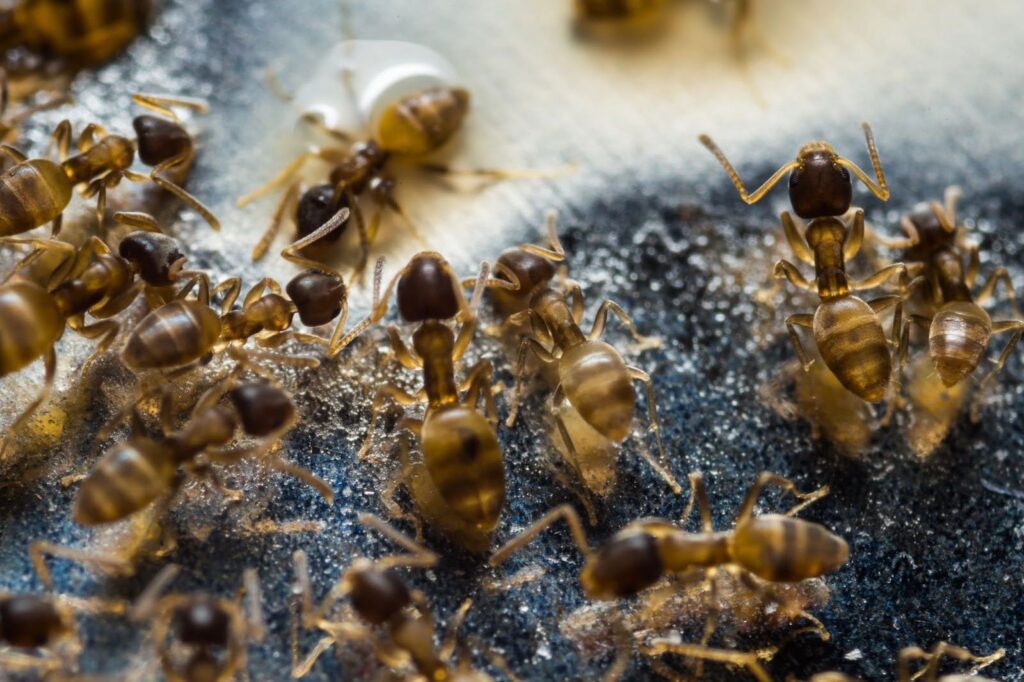
What’s crawling in your kitchen right now?
Just imagine yourself, enjoying the crisp fall weather in Canby or maybe a cozy evening in Salem. Then suddenly, you see a stream of tiny ants marching toward your kitchen counter. The culprit could be grease ants or sugar ants, but how do you know which? And does it even matter?
Knowing the difference between grease ants vs. sugar ants does matter, perhaps more than you think. Treating the wrong ant species with the wrong methods won’t make the slightest dent in your pest problem.
Here’s an in-depth comparison to help you understand these common household invaders so you can stop them before the problem grows out of control.
Grease Ants vs. Sugar Ants: The Physical Differences

Though tiny, grease ants and sugar ants differ significantly in behavior, appearance, and preferences.
Grease ants are extremely small, usually about 1/32 of an inch. They’re yellow to light brown in color and, true to their name, are attracted to grease and protein-based foods. They feed primarily on dead insects, meats, and other greasy crumbs that might be left behind on your countertops.
They’re also known to steal food (and larvae) from other ant nests, hence their actual name “thief ants.” Outside, they nest in the soil under rocks or decaying wood, but indoors, you can find them behind baseboards, wall voids, or inside cabinets.
Sugar ants, technically known as odorous house ants, are usually black or dark brown. They’re slightly larger than thief ants, at roughly ⅛ of an inch, and prefer foods high in sugars like spilled soda, honey, or sugary snacks. Their name comes from the unpleasant, rotten coconut smell they emit when crushed.
Outdoors, you’ll find them in the soil or underneath stones, while indoors, they’re primarily attracted to walls, cracks, and other small crevices.
Why Proper Identification of These Ants Matters

If you mix up grease ants with sugar ants, your efforts to evict them could go to waste. For instance, using sugar-based baits for grease ants likely won’t work because they prefer proteins or fats.
Similarly, treating sugar ants with the wrong products might reduce their numbers temporarily, but they will simply find another food source.
This is where hiring professionals like our team at Kanga Pest Control can make all the difference. We are trained to accurately identify and treat each species with the right techniques and materials to provide you with longer-lasting results.
How to Manage Grease and Sugar Ants in Canby & Salem Homes

Ant infestations don’t solve themselves. Below are some of our best tips for tackling either species:
- Seal Entry Points: Check and seal cracks near windows, doors, and baseboards.
- Eliminate Food Sources:Store sugary and greasy foods in sealed containers.
- Maintain Proper Hygiene: Clean up crumbs, spills, and grease from counters and floors promptly.
- Fix Moisture Issues: Address leaky pipes or standing water, especially in kitchens or bathrooms.
Wondering if you can DIY your way out of an ant problem? While professional pest control will always be the best solution, there are a few natural remedies you can try. For example, vinegar mixed with water can disrupt ant trails and repel them temporarily.
When to Call in the Professionals for Ant Control
Unfortunately, natural remedies and DIY fixes sometimes only scratch the surface of the problem. Ant infestations often involve hidden colonies, and unless you strike directly at the nest, the ants will keep coming back.
With Kanga Pest Control, you receive targeted treatments that go beyond surface-level fixes. Serving the Canby and Salem areas, we combine local expertise with advanced materials to ensure every ant problem is handled effectively. We even back our services with a satisfaction guarantee.
Don’t wait for more ant trails to pop up! If you’re having trouble identifying the difference between grease ants vs. sugar ants, get in touch with Kanga Pest Control today. We’ll help you save time, effort, and frustration. Fast action makes all the difference, no matter what kind of ant you’re dealing with.
Did You Know?
Grease ants, or thief ants, are among the smallest household ants, measuring just 1/32 of an inch! Their tiny size allows them to forage for food in places like electrical outlets, packaged products, and even inside walls. Meanwhile, sugar ants are called odorous house ants because of the funky smell they emit when squished.
FAQ
What attracts grease ants to my kitchen?
Grease ants are drawn to protein-rich or greasy foods. Common attractions include leftover meat, oils, and greasy spills around stoves or countertops.
How can I tell if I have sugar ants instead of grease ants?
If you notice ants flocking to sugary substances like syrup, soda, or candies, you likely have sugar ants. Grease ants tend to favor protein and fats over sweet treats.
Are store-bought solutions effective for ant infestations?
Store-bought traps or sprays may offer temporary relief but often fail to eliminate the root of the problem. Professional treatments ensure lasting results.
How does Kanga Pest Control handle ant infestations?
We combine accurate ant identification with targeted treatments designed for specific species. Our expert team ensures your home in Canby or Salem is protected from future infestations.
